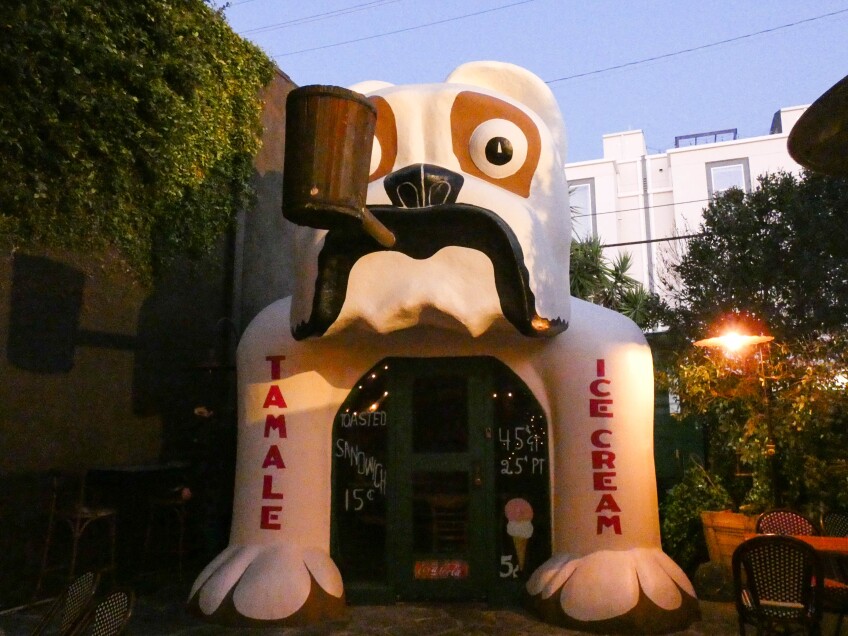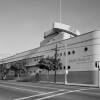7 Weird Buildings Still Serving ‘California Crazy’

Los Angeles used to be a city filled with fanciful buildings in the shape of derby hats, owls, sphinxes, windmills, ships, pigs, pups and more — all in service to car culture, luring passerby motorists to pull over, turn off their engines and cool their brakes for a while.
This style of architecture became known as "California Crazy" — a type of vernacular design that often mimicked the products that the business was selling. (See also: a shoe repair shop located in a giant shoe.) Hence its other nickname, mimetic architecture.
Much of that whimsy — also known as programmatic architecture — has gone by the wayside. At some point, architecture became really serious business.
But there are some holdouts that have held on — sometimes by a very thin, unraveling thread — thanks to historians and preservationists who've fought to save them. Some quirky buildings have even come back to life, better than ever.
Because what was once novel in the last century is just as weird and wondrous today as 80, 90, or 100 years ago.
And when it comes to drawing customers into the door, is novelty really such a bad thing?
After all, it's part of the fabric of Los Angeles. It's a little Hollywood-style set design magic — brought out onto the streets for regular folks to experience on an everyday basis, if they want to.
So whether you'd like to whet your whistle inside a whiskey barrel or fill your belly inside a bowl, here are seven places where you can feast your eyes upon some of the oddest and most entrancing remains of L.A.'s wackiest roadside architecture.
1. Idle Hour, North Hollywood

Idle Hour — the former Barrel Café, Rudy's Keg and La Caña Restaurant (1971-1984) — was restored in 2015 by 1933 Group, the nightlife organization behind historically sensitive reopenings of such other landmarks as Formosa Café, Highland Park Bowl and the forthcoming return of the hotdog-shaped hotdog stand Tail O' the Pup. This one is located on Vineland Avenue — just a couple of miles away from and smack-dab between Universal Studios, Disney Studios, Warner Brothers Studios and CBS Radford Studios.
First established in 1941 and designated Los Angeles Historic-Cultural Monument #977 in 2010, Idle Hour was designed in the shape of a whiskey barrel to serve thirsty workers on their off hours (and put something in their idle hands). Today, it hosts happy hour, dinner, brunch (including a monthly drag brunch event called "Bottomless") — and is home to another example of wacky roadside architecture, a replica of the former Bulldog Café. The original stood on West Washington Boulevard near the juncture of the present-day 10 and 110 Freeways from 1928 to the 1960s (ish, depending on what your source is).

Nestled snugly in the back of Idle Hour's patio, the pipe-smoking bulldog was forklifted out of and relocated (in pieces) from the Petersen Museum. This canine example of mimetic architecture was a centerpiece of the Petersen Automotive Museum's once-permanent exhibit on Los Angeles streetscapes that debuted with the museum's opening in 1994 and taken down with its 2014 redo. Although a scale replica, it's still a relatively giant dog — one that advertises both tamales and ice cream and is big enough to seat small private parties.
2. The Donut Hole, La Puente

While Los Angeles still has some examples of its defunct "Big Do-Nut Drive-In" chain — including the Randy's Donuts location by LAX as well as Kindle's Donuts (the oldest of the lot), Donut King II, Dale's Donuts and Bellflower Bagels — there's only one larger-than-life donut that comprises an entire building. And it's one you can actually drive through: The Donut Hole, the last remnant of the Donut Hole donut shop chain that once boasted five locations. (This one was the second to be built.)
In continuous operation in La Puente since 1968, the genius of it is that you don't just drive through one giant fiberglass donut — but two, connected by a tunnel that houses the kitchen and the take-out window. The design of this particular behemoth of baked goods has been credited to the architectural trio of John Tindall, Ed McCreany and Jesse Hood.
Line up in your car along the driveway (once known as "Do-Nut Blvd.") and wait your turn to enter the chocolate-glazed tunnel. Upon entry, you can already smell the raised dough and the glaze; and as you creep forward, you catch glimpses of what's fresh. Or, if you prefer to get your baked goods on foot without the red glow of brake lights ahead or the hurried flash of high beams behind, there's a small lot where you can park and use the walk-up window. Either way, it's cash only.
3. Chili Bowl, Alhambra

The westside of Los Angeles was just dealt a huge blow when the demolition fence recently went up around an original Chili Bowl restaurant at the corner of Pico and Wellesley Avenue, where the round building had stood since being relocated from Silver Lake in 1939. Originally built in 1935 by Art Whizin "The Chili Bowl King," it later was known as Mr. Cecil's California Ribs. It was most recently was open to the public as the Michelin-starred Shunji Japanese Cuisine, which operated there from 2012 to 2020.
The exact fate of that Chili Bowl location is unclear. Preservationists have been advocating for salvage and relocation as the demolition permit submitted by the owner was approved by Los Angeles city officials. In the meantime, there are a couple of other extant examples of the Chili Bowl restaurant chain's programmatic architecture. The chain once had as many as 23 locations — all of which ceased operations in 1947 (some of which are being converted by Whizin into Punch & Judy Ice Cream Parlors).
In Glendale, there's one at the corner of San Fernando Road and Winchester Avenue (most recently the office of Valley Dealer Exchange, a now-closed used car dealer) — although its condition is not exactly intact. In Huntington Park, you can admire the former Guadalajara Night Club at the corner of Florence Avenue and Marbrisa Avenue, which has been closed for years.
If you're interested in visiting a restaurant that currently occupies a chili bowl-shaped building, head to Valley Boulevard and South 5th Street in Alhambra, where Ho Kee BBQ & Noodles is open for business (after recently taking over the space from K.C.Y. Restaurant).
4. Brolly Hut, Inglewood

There may be two Brolly Hut locations in L.A., but only one of them is in the actual shape of an umbrella: on Crenshaw Boulevard and W. 112th Street in Inglewood. Although more Googie-style in nature, if you want to get technical — since umbrella-shaped buildings of the time were selling burgers or gas and not umbrellas — this fast food joint is a tasty treat for breakfast, lunch or dinner. And it's the last of its kind in L.A.
Originally built in 1968 and designed by architect Victor Miller, it opened as the Bumbershoot Café ("bumbershoot" is another word for umbrella, just as "brolly" is across the pond). Brolly Hut took over the space in 1971 and kept the umbrella theme — including umbrella-shaped lighting fixtures hanging from the ceiling.
For another umbrella-shaped eatery, venture to Seal Beach — where a former location of the Googie-style Parasol restaurant chain (built 1967 and designed by Kanner-Mayer Architects) still stands at 12241 Seal Beach Boulevard. It was threatened with demolition with the development of The Shops at Rossmoor complex — but now, its exterior is preserved as a Panera Bread (after a stint operating from 2008 to 2009 as a Mel's Drive-In).
5. Spare Tire Kitchen & Tavern, Miracle Mile

No, Spare Tire isn't shaped like a tire (nor does any of the foods it serves, for that matter). Rather, this storefront has a three-dimensional, sculptural façade that's the only clue left as to its original life — as a camera shop. Built in 1926, the building was remodeled in 1938 by its then-tenant The Darkroom, which added a reinforced concrete storefront featuring black Vitrolite glass sheathing and clear glass bricks in a sleek, Streamline Moderne style.
Its 35mm camera façade (designed by architect Marcus P. Miller, complete with shutter-speed indicator) was designated Los Angeles Historic-Cultural Monument #451 in 1989. Unfortunately, its original neon sign was removed — but was preserved, and is currently in the collection of the Museum of Neon Art. It's been operating as Spare Tire since 2014 — and was previously known as the Indian restaurant Sher-E Punjab Cuisine and the Mexican-themed restaurants La Boca del Conga and El Toro Cantina (the latter replete with a thatched awning and a fish tank in the camera lens).
Located within the former major shopping district of Wilshire Boulevard that also included the May Company and Desmond's — along what became known as the "Fifth Avenue of the West," now better known as "Museum Row" (for its proximity to LACMA, the Petersen and others) — it's a major contributor to what's today's Miracle Mile Historic District.
6. The Tamale, East Los Angeles

A number of paint jobs have changed its exterior color over the years, but the "Tamale Building" (or the "Giant Tamale" or simply "The Tamale") still stands in East L.A., despite several preservation threats. This appetizing architecture dates back to 1928, when it called out to motorists passing by along Whittier Boulevard who might be hungry for a quick snack.
Back then, there wasn't much development in the area — but it later became dotted with wacky establishments like this, earning Whittier Boulevard the moniker "Oddball Row" as the preservationists at Esotouric call it. As those other oddities disappeared, The Tamale became surrounded by more mundane businesses like furniture stores, medical offices, realtors and even a tattoo studio.
Sadly, you can no longer get a tamal there (nor any of the other foods it once sold, like malted milk, hamburgers, pie, or chili). Recent decades have seen a number of businesses operate out of The Tamale since it ceased being a tamaleria, like a Charley's Beauty Salon and even a dental office. But it's currently vacant — and could sure use a loving owner (with an appreciation of the quirky) to reactivate this East Los landmark once again.
7. The Coffee Pot Café, Long Beach
Currently open as the Salon Benders beauty salon, the Coffee Pot Café (also Hot Cha Café, from 1934-1982) was built in 1932 to look like a coffee percolator — perfect for a coffeehouse! But since the 1960s, the coffee-themed building has also been used as a weed dispensary and a barber shop.
More interestingly, a renovation effort revealed that the pot may have been built upon the frame of an old Victorian home — making its architectural provenance even older than anybody thought.
Fortunately, the Long Beach city landmark (since 1991) and Long Beach Heritage Preservation Award-winner managed to dodge the wrecking ball despite years of neglect. It is once again brewing up business. You can find it at 957 East 4th Street in Long Beach.




